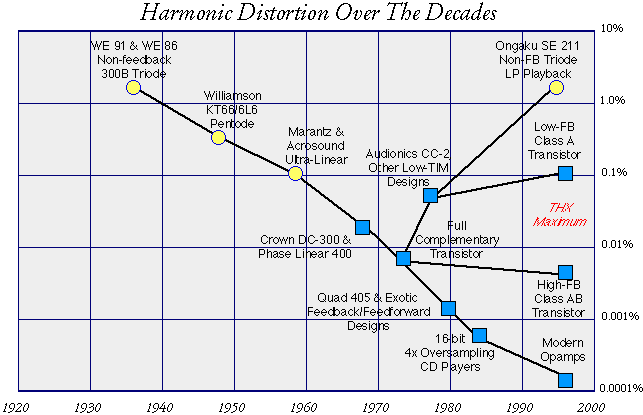
This chart marks the path that amplifier THD has taken over time, with colored dots indicating the presence of a landmark designs that others followed, such as the Williamson or the fully-complementary transistor amplifier. It shows that for a few designers, the THD figure has lost the powerful grip it once held on the industry, while for others, they continue to do all they can to drive it lower and lower.
It's interesting to note that a Western Electric 91A amplifier (with 20 years of actual theatre service) selling for $8,000 in Akihibara would fail the THX distortion limit, while a mass-market receiver selling for $599 would certify. Makes you think, doesn't it?
The problem with using THD as a yardstick of quality is the order of the distortion term has a far more audible effect than its absolute magnitude. When you have 3 or more fundamental tones, the number of IM sum-and-difference terms are much worse when you have to contend with a large number of harmonics past the third. This was first discussed by Norman Crowhurst and D.E.L. Shorter of the BBC in the mid-Fifties, so it's hardly a new or radical concept.
Regrettably, the single-tone additive THD and the SMPTE or CCIF IM tests in common use today do not take this into account, thus ignoring the far more audible effects of the upper harmonics with real musical sources, which invariably have more than 3 fundamental tones. With real music, the large number of sum-and-difference terms modulate the noise floor of the musical program, covering up the low-level room reflections the listener uses to analyze the spatial qualities of the performing space.
The market-driven pursuit of the ever-lower THD number is why the audio industry progressively abandoned of linear amplifying devices in favor of less linear devices with more gain, and turned to circuits that used greater and greater amounts of feedback. With each step the THD figure moved downward, while the harmonic structure became less predictable and more complex. In the early decades, when all audio equipment produced several per cent distortion, the THD figure told you something about how it might sound. Today, with low-fi car stereos producing less than 0.01% distortion, the specification no longer has any meaning.
This long-term trend was a direct result of Norman Crowhurst and D.E.L. Shorter losing the distortion-weighting debate of the 1950ís. Back in the days of the slip-stick, who wanted to calculate all of those terms out to 9th or higher? Worse, their proposals cast question on the wisdom of choosing high-feedback pentode circuits over low-feedback triode circuits. When the 2A3-powered Brook went out of production, the triumph of the Williamson was complete. No triode amps were made anywhere. The debate was over.
With nobody minding the store, the industry was to free to take the next big step downward: transistor sound, in an ugly quasi-complementary debut. It took 20 years of very challenging work to get transistor amps to approach the quality of the pentode amps they obsoleted. By the time transistor amps had reached a rough sonic parity with their direct predecessors, the much older triode technology, along with the weighted-harmonic debate, had been forgotten.
Now that amplifiers had been "perfected" (in the thinking of the AES mainstream), it was time to extend the same THD philosophy to recording media; digital sound replacing analog tape and records. And once again it has took another 20 years of difficult work to approach a rough sonic parity with the systems it replaced. Certainly, full credit must be given to companies for Sony/DSD and dCS upsampling, but what's the point of wasting 20 years to end up right where we started?
This time, though, unlike the solid-state fiasco, we leave behind a legacy of 20 years of low-resolution 44.1/16 digital recordings. It'll take some pretty fancy fractal-analysis technology to add resolution that simply isn't there in the data storage medium. Those bits fell on the floor during the first A/D conversion, never to be recovered, only guessed at by clever computer algorithms many years later. Not only that, the future of high-resolution digital recording is far from guaranteed; the majority of recordings made right now are still at the 44.1 or 48 kHz rate with a stored resolution no better than 20 bits.
This is why listening to a 30ips mastertape (the original speed used by Ampex in 1948!) or a good LP (also introduced in 1948) on a 2A3 or 300B amplifier is a profoundly disturbing experience for an audiophile with a sense of history.
What do we have to show for a half-century of two-steps-forward, one-step-back? What direction would audio have taken if distortion-weighting had been taken seriously when it was first proposed?